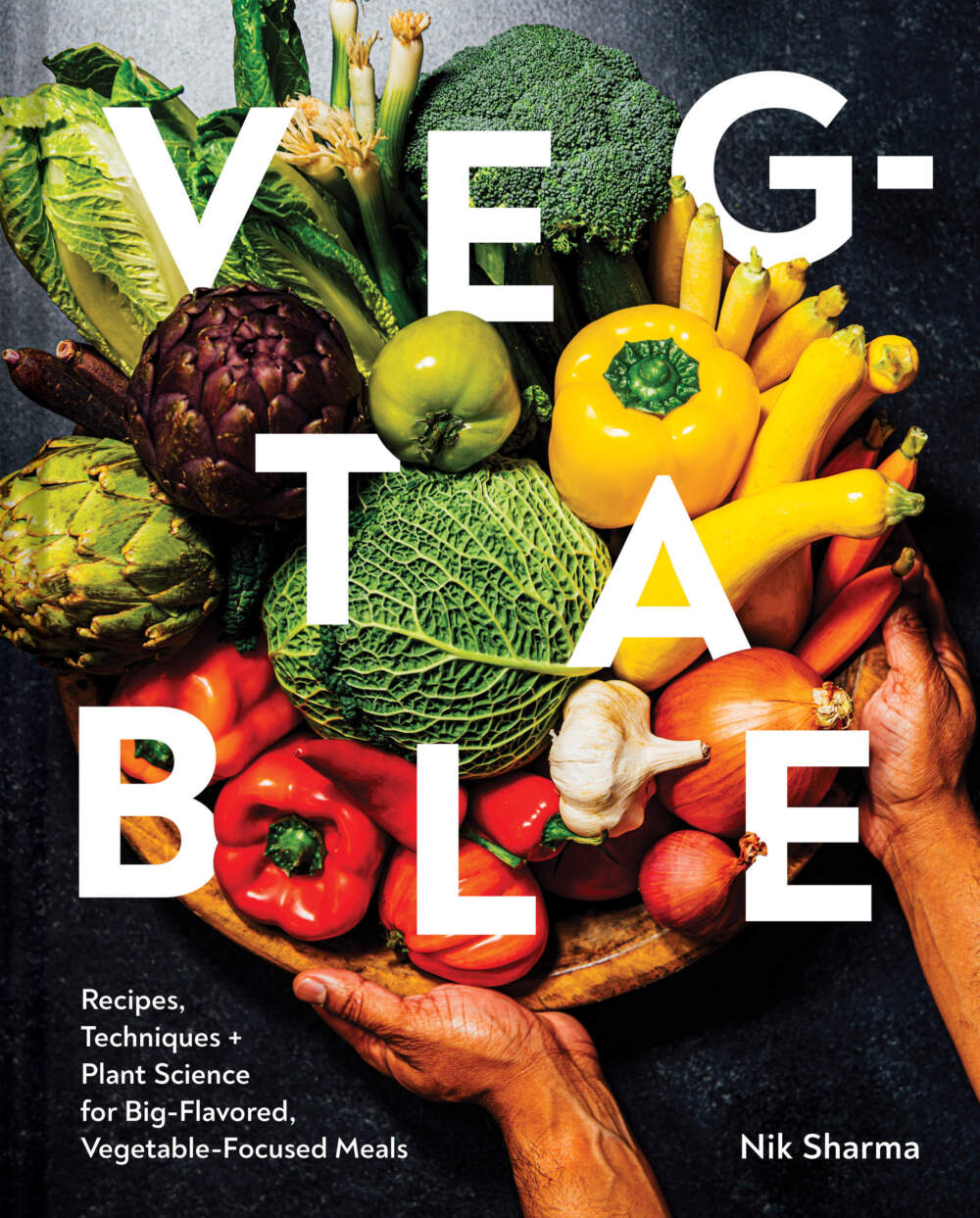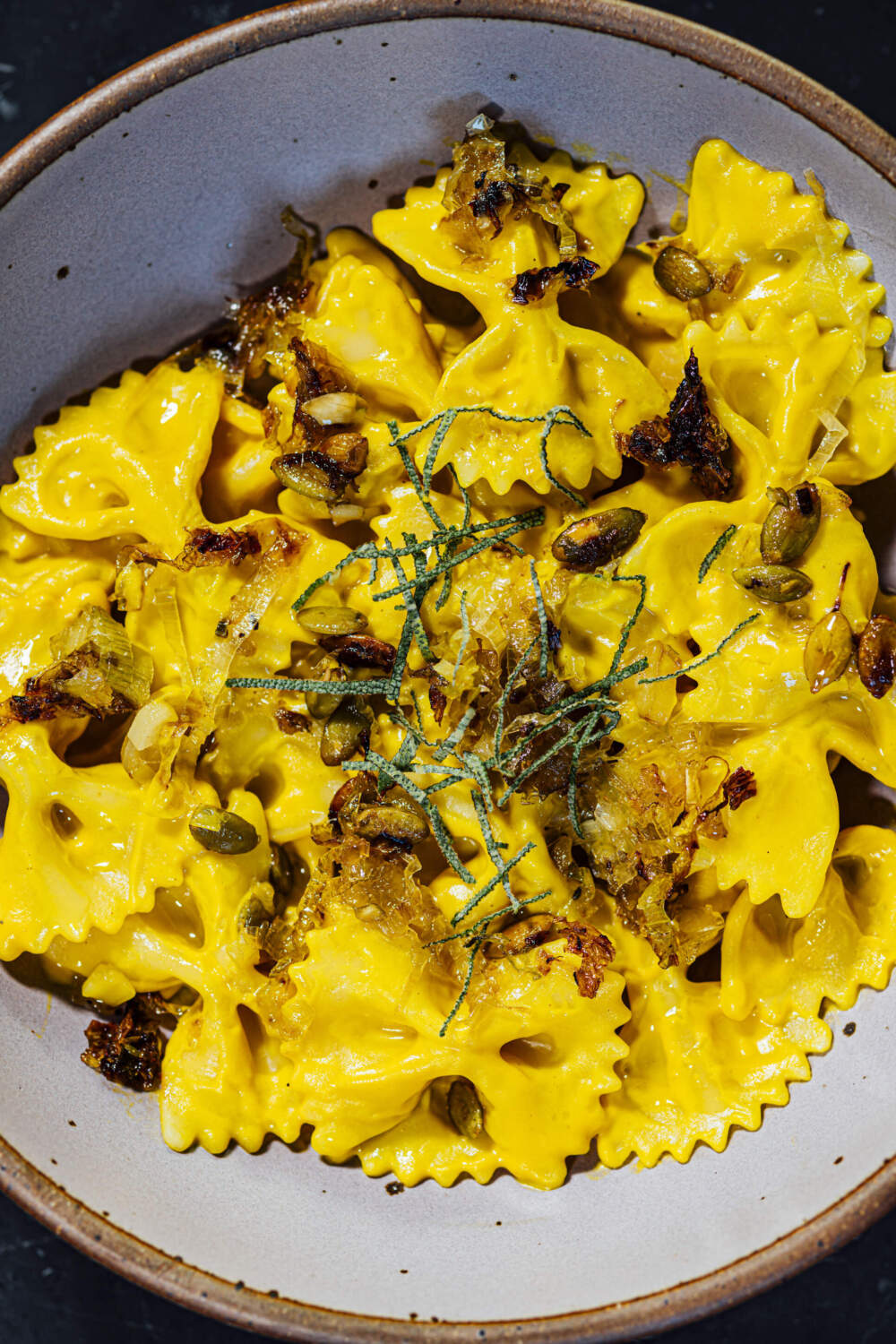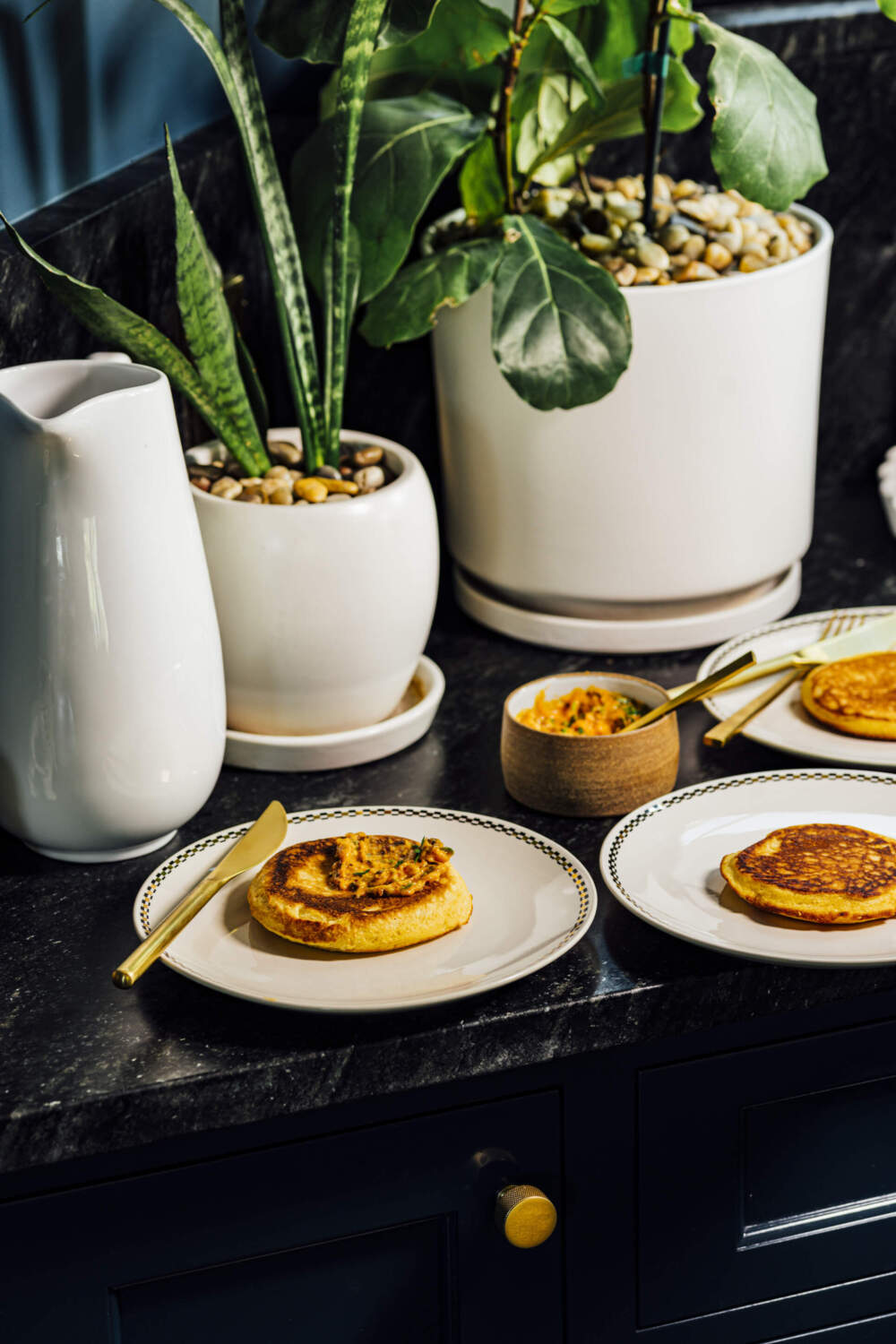Advertisement
'Veg-table' cookbook seeks to make vegetables more central to your diet
Resume
When author and photographer Nik Sharma went looking for a book that applied the science of vegetables to cooking, he couldn’t find anything.
So he wrote his new cookbook, "Veg-table: Recipes, Techniques + Plant Science for Big-Flavored, Vegetable-Focused Meals," to share his scientific knowledge with other people.
The book is full of tips based on plant science, such as the importance of knowing how plant science classifies vegetables.
Take potatoes, for example. Techniques that work for potatoes — like applying baking soda and salt to make them creamier — work for other starchy vegetables from different parts of the plant kingdom, Sharma says.
“Cassava, yucca, these are all vegetables that are really starchy,” he says. “You can apply the same techniques and get those same textures just because they're starchy.”
In addition to teaching people how to cook smarter, Sharma wants to help people incorporate more vegetables into their diets.
“I'm not a dietitian by any means, and my goal is not to give long lectures,” he says. “My goal is to tell people, ‘Hey, vegetables are fun. I want you to try cooking with them. I want you to try new vegetables.’”

Book excerpt: 'Veg-table'
By Nik Sharma
Crispy salmon with green curry spinach
My aunt Elaine is a firm believer that salmon should not be used in curries because it becomes unpleasantly firm, unlike many other fish. But what if the salmon is cooked separately and served on the side? This recipe might be tailored for my aunt, but you will enjoy it too. Coconut rice or plain rice are both excellent options to serve alongside.
MAKES 4 SERVINGS
In a large cast-iron or stainless-steel skillet over medium-high heat, warm 2 Tbsp extra-virgin olive oil. When the oil is hot, add 2 Tbsp drained capers. Sauté until crispy and lightly golden brown, 1½ to 2 minutes.
Add 1 large red onion, minced. Sauté until translucent, 4 to 5 minutes. Add 2 Tbsp green curry paste and 4 garlic cloves, thinly sliced. Sauté until fragrant, 1½ to 2 minutes. Add, a handful at a time, 1 lb [455 g] fresh baby spinach. Sauté, tossing, until the leaves are completely wilted and most of the liquid evaporates, 10 to 12 minutes. Stir in 1 cup [120 g] fresh or frozen peas, 1 cup [240 ml] unsweetened coconut milk, ½ cup [120 ml] water, and ½ tsp ground black pepper. Bring to a boil and let simmer until the peas turn tender, 1½ to 2 minutes.
Stir in 1 Tbsp fresh lime or lemon juice and 1 tsp low-sodium soy sauce. Taste and season with fine sea salt. Remove from the heat and cover to keep warm.
Use clean paper towels to pat dry four 6 oz skin-on salmon fillets. Season on both sides with fine sea salt and ground black pepper.
In a large cast-iron or stainless-steel skillet over medium heat, melt 2 Tbsp unsalted butter. Cook until the butter stops crackling and its water evaporates, 2 to 3 minutes.
Add 2 Tbsp extra-virgin olive oil. Place the salmon fillets on the hot pan, skin side down. Cook without moving the fillets (if moved before the skin is fully cooked, the flesh can easily tear away from the skin). After the first 5 minutes of cooking, tilt the skillet toward you and use a large spoon to collect the oil in the pan and pour it over the fish fillets. Cook until the skin starts to turn golden brown and crispy on the sides, another 1 to 2 minutes. Transfer the cooked fish from the pan to a plate. Serve with the spinach and garnish with a few sprigs of cilantro or microgreens like arugula or kale.
THE COOK’S NOTES
- The milk proteins in the butter will help the fish skin cook well and also release easily. The proteins bind to the metal surface of the pan, creating a nonstick surface that will help the fish slide off with ease after cooking.
- If you don’t eat fish, make a batch of the Bok Choy and Crispy Tofu (page 166) and serve it on top of the curry. Seared slices of tempeh or fried eggplant are also wonderful options here.
- There are several terrific brands of Thai curry paste available online and in grocery stores. One of my favorites is the Mekhala brand of curry pastes (they’re vegan!).
- I sometimes add chunks of squash like pumpkin and other cucurbits like chayote to this curry.
Butternut squash sauce, crispy leeks + farfalle

Farfalle is my favorite pasta shape, quite possibly because it’s one of the most playful ones. So there was no way I’d leave it out of this book. This pasta sauce is remarkably easy to put together and produces superior results. But, best of all, it takes less than an hour to prepare, making it a great meal for a busy weekday. Roast, blend, and season the butternut squash to make the sauce, and top the pasta with plenty of crispy leeks.
MAKES 4 SERVINGS
Preheat the oven to 400°F [200°C].
On a rimmed baking sheet, toss together 1 lb [455 g] peeled and seeded butternut squash, diced into 1 in [2.5 cm] cubes, and 1 Tbsp extra-virgin olive oil. Spread in a single layer and roast until completely tender and lightly caramelized, 30 to 45 minutes. Remove from the oven and transfer to a medium saucepan.
To the saucepan, add 2 cups [480 ml] water; ½ cup [70 g] unsalted raw cashews; 2 garlic cloves, smashed; ½ tsp ground turmeric; ¼ tsp ground cayenne; ¼ tsp baking soda; and ⅛ tsp ground nutmeg. Bring to a boil over medium-high heat. Remove from the heat and let sit for 5 minutes.
Transfer the mixture to a high-speed blender or food processor. Add 3 Tbsp white or yellow miso and, using caution, carefully blend the hot liquid until silky smooth. Keep the top of the blender covered with a dish towel to help keep the sauce warm.
While the squash and cashew mixture is simmering, bring a large pot of salted water to a boil and cook 1 lb [455 g] farfalle to al dente, per the package instructions. Reserve 1 cup [240 ml] of the pasta water, then drain the cooked pasta and transfer to a large bowl.
Meanwhile, in a medium saucepan, warm ¼ cup [60 ml] extra-virgin olive oil over medium-high heat. Lower the heat to medium-low and add 2 medium leeks, trimmed and thinly sliced, and ¼ tsp fine sea salt. Sauté until lightly golden brown and starting to crisp, 10 to 20 minutes (this might take longer and, just like browning onions and life, is unpredictable when it comes to time). If they start to burn, add 1 Tbsp water and scrape the bottom of the pot. Add 2 Tbsp raw unsalted pumpkin seeds and 1 tsp red pepper flakes such as Aleppo, Maras, or Urfa. Sauté until the seeds start to brown, 1 to 2 minutes. Remove from the heat, taste, and season with fine sea salt. When ready to serve, fold the pasta into the sauce, adding some of the reserved pasta water, 1 to 2 Tbsp at a time, to make the sauce glossy (the sauce will become drier as the pasta sits). Top with the crispy leeks and pumpkin seeds. Garnish with 4 large fresh sage leaves, thinly sliced.
Serve hot or warm. Store leftover pasta in an airtight container in the refrigerator for up to 3 days. When reheating, add 1 to 2 Tbsp water to rehydrate the pasta.
THE COOK’S NOTES
- What holds this pasta sauce together is the combination of butternut squash, cashews, and garlic. They each contain emulsifying agents that make the sauce cling to the noodles.
- Baking soda and salt help soften the tough pectin in the squash and pave the way for creating a velvety pasta sauce.
- A high-speed blender does a fantastic job of making a smooth purée. If you don’t own one or your blender isn’t the strongest, substitute ½ cup smooth cashew butter in place of the cashews.
- Shallots are an excellent alternative to leeks here.
- For a “cheesy” taste, blend in 1 Tbsp nutritional yeast with the roasted squash.

Corn cakes with Sichuan chive butter
MAKES 4 SERVINGS
Sichuan chive butter
To prepare the butter, in a small bowl fold together ½ cup [110 g] unsalted butter, softened; 3 Tbsp chopped chives; 2 generous Tbsp solids from a jar of chili crisp; and 1 garlic clove, grated. Add, as needed, flaky sea salt. The butter will store well for up to 3 days in an airtight container in the refrigerator.
Prepare the corn cakes by whisking together 1 cup [140 g] medium-grind cornmeal, 1 cup [120 g] cake flour, 1 tsp fine sea salt, ½ tsp ground turmeric, ½ tsp baking powder, and ¼ tsp baking soda.
In a medium mixing bowl, whisk together 1 cup [240 ml] buttermilk or kefir, ¼ cup [50 g] packed dark brown sugar, 2 large eggs, and 2 Tbsp melted ghee, butter, or other neutral oil with a high smoke point such as grapeseed. Make a well in the center of the cornmeal mixture, pour in the liquids, and whisk until smooth and combined.
Melt ½ Tbsp unsalted butter in a large cast-iron skillet or on a griddle over medium-low heat. Spoon out one-fourth of the batter in the center and spread evenly into a circle that’s approximately 6 in [15 cm] round. Cover the skillet with a lid and cook until the corn cake starts to become crispy and golden brown on the bottom, 2 to 3 minutes. Then flip the corn cake with a large spatula, cover, and cook again until crispy and golden brown on the other side, 2 to 3 minutes. Transfer to a plate and cover with a kitchen towel to keep warm. Prepare the remaining corn cakes, adding more butter to the pan as needed between batches.
Serve the corn cakes warm topped with a generous pat of the Sichuan chive butter.
Store leftover cakes refrigerated, in an airtight container; store the butter wrapped in parchment paper in an airtight container.
Some people love pancakes for breakfast; I love corn cakes. I love them so much, I’d run a marathon if they were waiting for me at the finish line. These golden corn cakes with their crispy brown edges, topped with a generous spoonful of melting Sichuan chive butter, are the perfect combination of sweet, savory, spicy, and hot. Be generous with the butter.
THE COOK’S NOTES
- Cake flour has a lower protein content, so it produces a much more tender crumb than all-purpose flour.
'Veg-Table: Recipes, Techniques + Plant Science for Big Flavored, Vegetable-Focused Meals' by Nik Sharma. © 2023. Published by Chronicle Books. Photographs by Nik Sharma.
This segment aired on December 20, 2023.

